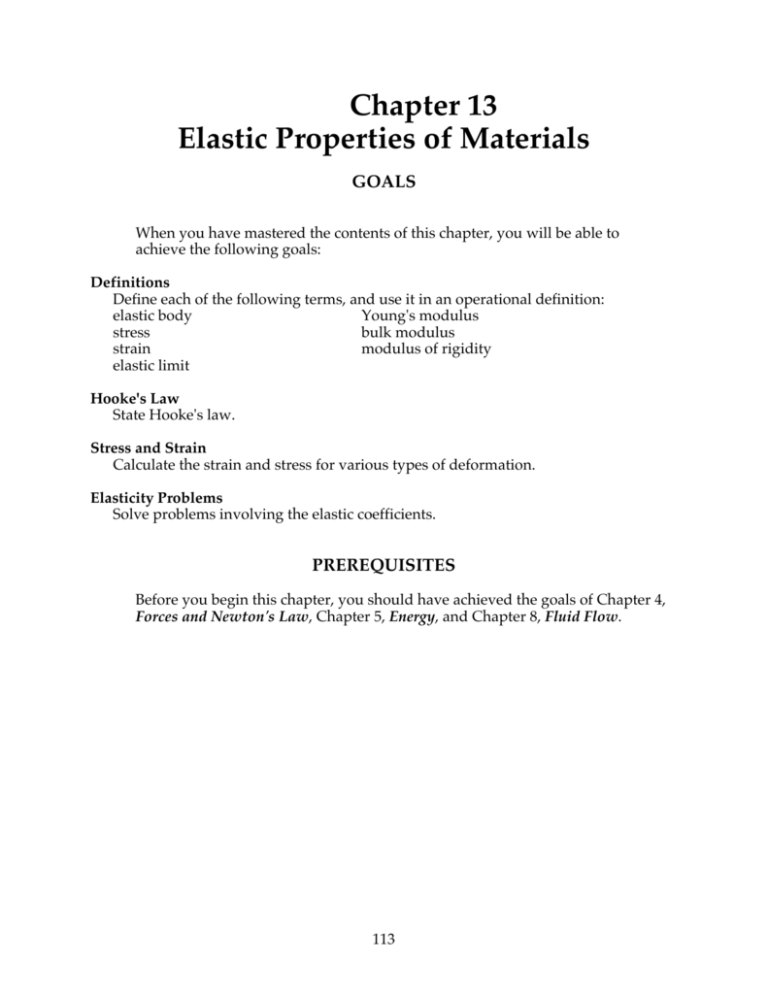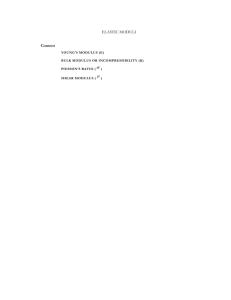Chapter 13 Elastic Properties of Materials
advertisement

Chapter 13 Elastic Properties of Materials GOALS When you have mastered the contents of this chapter, you will be able to achieve the following goals: Definitions Define each of the following terms, and use it in an operational definition: elastic body Young's modulus stress bulk modulus strain modulus of rigidity elastic limit Hooke's Law State Hooke's law. Stress and Strain Calculate the strain and stress for various types of deformation. Elasticity Problems Solve problems involving the elastic coefficients. PREREQUISITES Before you begin this chapter, you should have achieved the goals of Chapter 4, Forces and Newton's Law, Chapter 5, Energy, and Chapter 8, Fluid Flow. 113 Chapter 13 Elastic Properties of Materials OVERVIEW This is a short but important chapter concerning the reaction of materials to deforming forces. The recognized method for reporting these results for various materials is a number called Modulus, which is simply the ratio of stress to strain. Thus Young's Modulus, the Modulus of Rigidity, and the Bulk Modulus rate a material's reaction to forces producing elongation, change in volume, or sheer distortion respectively. SUGGESTED STUDY PROCEDURE Before you begin to study this chapter, be familiar with the Chapter Goals: Definitions, Hooke's Law, Stress and Strain, and Elasticity Problems. An expanded discussion of each of the terms listed under the Definitions goal can be found in the Definitions section of this Study Guide chapter. Next, read text sections 13.1-13.5, and consider the Example problems discussed. Please note the three major measures of elastic properties of matter outlined in table 13.1 on page 297. These are Young's Modulus, the Modulus of Rigidity and the Bulk Modulus. At the end of the chapter, read the Chapter Summary and complete Summary Exercises 1-11. Check your answers against those given on page 301. Now do Algorithmic Problems 1-5 and do Exercises and Problems 1, 2, 5 and 6. For additional work, turn to the Examples section of this Study Guide chapter and complete each problem. Now you should be prepared to attempt the Practice Test found at the end of this Study Guide chapter. If you have difficulty with any of the answers, please refer to the appropriate text section for additional assistance. ---------------------------------------------------------------------------------------------Chapter Goals Suggested Summary Algorithmic Exercises Text Readings Exercises Problems & Problems ---------------------------------------------------------------------------------------------Definitions 13.1,13.2 1-9 Hooke's Law 13.3 3 Stress and Strain 13.4,13.5 1,2,4 Elasticity Problems 13.4,13.5 10,11 5 114 1,2,5,6 DEFINITIONS ELASTIC BODY - Any material or body which is deformed by an applied force and returns to its original shape after the distorting force is removed. We often think of elastic materials as the ones most easily distorted from the original shape, such as rubber bands. In physics, a high elastic material requires a large force to produce a distortion. This notion is contrary to the common use of the word. STRESS - Ratio of the applied force to the area. This is the force applied to change the shape of an object. STRAIN - Ratio of change in a given physical dimension to the original dimension; i.e., change in length to original length, or change in volume to original volume. This is the measure of the changes in shape of an object acted upon by a stress. ELASTIC LIMIT - Limit of distortion for which deformed body returns to original shape after deforming force is removed. Many students have their lives so stretched by college that they cannot return to their original life. Have they exceeded their elastic limit? YOUNG'S MODULUS - Elastic constant of proportionality for a linear deformation. For most solids this is a large number ~1010 N/m2. To stretch most solids by even 1% we would need to apply a pressure of about 1000 times the pressure of the atmosphere. BULK MODULUS - Elastic constant of proportionality for a deformation of volume. This can be measured by squeezing an object in a hydrostatic press and measuring its change in volume. MODULUS OF RIGIDITY - Elastic constant of proportionality for a shear deformation. Some materials, such as graphite, shear much more easily in one direction than in others. EXAMPLES ELASTICITY PROBLEMS 1. A measuring device is able to apply a force of 1.0 x 105 N. A student wishes to use the device to study the elastic properties of a 1 cm cube of steel. What is the student likely to find? What Data Are Given? The applied force = 1.0 x 105 N. The material being studied is steel whose elastic coefficients are given in Table 13.1. What Data Are Implied? It is assumed that the applied force is not too great so as to exceed the elastic limit of the steel sample. What Physics Principles Are Involved? We can make use of the basic definitions of the linear, bulk, and shear deformations. Then we can predict what will happen in each case. What Equations Are to be Used? Linear deformation ΔL/L = (l/Y) (F/A) (13.5) Bulk deformation ΔV/V = (-l/β)P (13.7) Shear deformation φ = (l/n)(F/A) (13.8) 115 Algebraic Solutions These are all given above, since we wish to predict the kinds of deformations that will occur in each case. Numerical Solutions 1) Suppose the student applies the 1.0 x 105 N force across the ends of the cube to stretch it. Then its length will be changed ΔL/L = (l/Y)(F/A) = (m2/ (10.0 x 1010 N)) x ((1.0 x 105 N)/(1 x 10-4 m2)) ΔL/L = 5.0 x 10-3. The new length = 1.005 cm. 2) Suppose the student uses the device to apply a 1.0 x 105 N force to each of the six faces of the cube; then the volume of the cube will be decreased. ΔV/V = (-l/β)P = ((-1)m2)/(16.0 x 1010N) = (1.0 x 105 N)/10-4m2 ΔV/V = -6.3 x 10-3; new volume = 9.937 x 10-7 m3 3) Suppose the student uses the device to apply a 1.0 x 105 N force tangent to the top of the cube while holding the bottom fixed, then the cube will be deformed by an angle φ where φ = ((1 m2)/(8.0 x 1010 N)) x ((1.0 x 105 N)/(1 x 10-4 m2)) = 1.25 x 10-2 radians φ = 0.72ø; so the sides of the cubes are inclined 0.72ø from vertical. Thinking About the Answers For which case is the elastic energy the greatest? In each case Hooke's Law is obeyed so the energy is of the form E = (½) kΔx2 but Δx = F/k so E = (½) F2/k; The energy is inversely proportional to the elastic constant for a constant force, so the most elastic energy is stored in the shear case (3) above. From where does the extra energy come? 116 PRACTICE TEST 1. Which of the three elastic moduli (Young's, Bulk, or Rigidity) are most important in each of the case below? ______a. A front car tire is deformed as the car rounds a turn on a flat dry road. ______b. In the use of a bicycle pump, a cyclist forces down on the pump handle to force the air into the flat tire. ______c. A workman uses a screwdriver to tighten a screw. (Consider your answer for the steel shaft of the screwdriver.) ______d. A rubber band is stretched to fit around a pile of loose papers. 2. Design an experiment for finding the elasticity constant for a rubber band. What equipment is needed? What measurements must be made? What results do you anticipate? 3. In an experimental test, the following data was collected for stretching a rubber "tiedown" strap: cross-sectional area, A = 5.3 cm2 ; length, L = 75 cm; elongating force, F = 10 Newtons; length increase, Δx = 4 cm a. Calculate the stress b. Calculate the strain c. Find a value for Young's Modulus for rubber. ANSWERS 1. Rigidity, Bulk, Rigidity, Young's 2. Your experiment should include known weights to be used to stretch the band. As the band stretches as each weight is added, the length of stretch should be measured. The elasticity constant in the ratio of weight to length of stretch. The results should give a constant K until the band is stretched to near its limits of elasticity. 3. Stress = 1.9 x 104 N/m2, strain = .05, Young's Modulus = 3.8 x 105 N/m2 117









